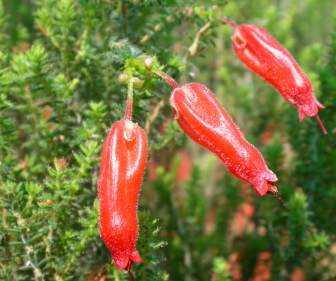Erica inordinata
Erica inordinata H.A.Baker
Family: Ericaceae
Common names: Kammanassie erica
Introduction
Erica inordinata is a lovely species that is not well known because it occurs at a rather high altitude on the insular Kammanassie Mountain Range near Uniondale. This robust plant produces lovely crimson flowers that are very showy during the summer months. Cuttings of this plant were collected in 1996 and established in the Kirstenbosch rare collections nursery. It is such a showy species that it will be propagated for the garden displays and for sale to the public. Plants should be available at the Annual Plant fair in 2005.

Description
Description
Erica inordinata is a robust, erect shrub, reaching about 1.2 m in height. It has dark green leaves closely arranged around sturdy stems. Bright red or crimson flowers are borne at or near the end of short branches from September to January. The flowers are tubular, very sticky and vary considerably in shape and size. There appears to be no pattern to the shape of the flowers, which occur on different parts of the same plant.The young flowers are usually narrow-tubular, swelling around the anthers. The lower portion of the flower gradually becomes fuller and more inflated with age. Older flowers tend to constrict at the centre of the tube producing a strange, throttled shape. The tubular shape and sticky nature of the flowers suggest pollination by sunbirds with long, pointed beaks or long proboscid flies that can hover while feeding on the nectar.
Conservation Status
Status
Erica inordinata is classified as rare in nature, but it should not be regarded as threatened by normal threats such as urbanization or alien invader plants. It is restricted in distribution, but common on the upper slopes of the Kammanassie. It may become threatened if there are too many fires that prevent it from building up its seed banks. The challenge for it and many other plants will be the ability to survive the stresses of environmental change in the form of global warming. Initial experimental findings by researchers (G. Midgley and C. F. Musil - pers. comm.) at the Kirstenbosch Research Centre are that a few degrees rise in average temperature has a serious effect on germination of fynbos plants.
Distribution and habitat
Distribution description
Erica inordinata grows on the upper slopes of the insular Kammanassie Mountain where it occurs singularly or in fairly dense stands. The Kammanassie Range is situated in the Little Karroo between the Great Swartberg and the Outeniqua Mountains. This species grows in acid, leached soils derived from weathered quartzite on the south and southwestern slopes, at an altitude varying from 1 500 to 1 900 m. The high altitude and southerly aspect ensures that it gets extra moisture from coastal cloud banks and that it experiences cooler conditions than on the surrounding Karoo plains.
Growing Erica inordinata
Grow
This plant grows successfully in containers up to 30 cm in diameter. The roots prefer to be confined and need good drainage. Plants should therefore be planted in rockeries where the soil is a little elevated or on a gentle slope. It requires full sunlight and free air circulation.
Plant in well-drained, acidic soils and mulch with rotted compost or wood chips. Regular pruning will improve the shape of the plant. Pruning also increases branching and flower production.
Plant in pots or in the ground. Water thoroughly and then allow the soil to partially dry out between watering. They should be regularly fed with seaweed-based, organic fertilizers. Controlled release fertilizers in the form of granules are also beneficial. These granules should be mixed into the soil prior to planting rather than sprinkled on the surface. Controlled release fertilizers are designed to release nutrients when conditions are hot and wet. If granules are concentrated on the surface, they can cause burning to the delicate surface roots typical of ericas.
Propagation
At Kirtstenbosch, this plant was established from cuttings collected in the field. Fresh, actively growing material was selected and treated with rooting hormone for semi-hardwood cuttings. Heel cuttings were taken using side shoots and placed in specialized propagation units with heated benches and overhead mist. The rooting medium consists of fine, milled pine bark and polystyrene balls. Cuttings root after six to eight weeks.
Seed is very difficult to collect because the flowers are so sticky. The seed becomes attached to the flower and is almost impossible to remove. It is possible that the dead, dry, seed-covered flowers tumble around the mountain slope and eventually settle in some resting place until fire triggers the new germination and growth cycle.
Seed, if available, should be sown in autumn and subjected to the normal smoke treatment.
References
- Baker, H.A. 1969. Three new species and a new variety of Erica. Journal of South African Botany 35: 25-33.
- Schumann, D. (Dolf) & Kirsten, G. (Gerard). 1992. Ericas of South Africa. Fernwood Press, Vlaeberg, Cape Town.
Credits
Anthony Hitchcock
Kirstenbosch National Botanical Garden
December 2003
Plant Attributes:
Plant Type: Shrub
SA Distribution: Western Cape
Soil type: Sandy
Flowering season: Spring, Early Summer, Late Summer
PH: Acid
Flower colour: Red, Orange
Aspect: Full Sun
Gardening skill: Challenging
Special Features:
Horticultural zones







Rate this article
Article well written and informative
Rate this plant
Is this an interesting plant?
Login to add your Comment
Back to topNot registered yet? Click here to register.